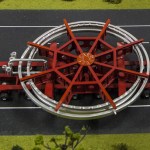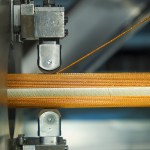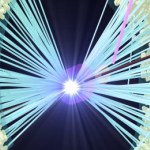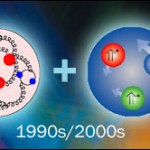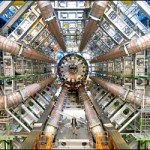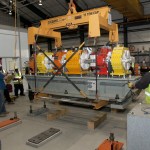accelerator technology
Big science is a massively collaborative endeavor. From the initial theoretical puzzles to the brilliant engineers that build on-of-a-kind machinery, experts come together to make discoveries happen. Case in point: We’re moving this 50-foot-wide physics experiment over 3,200 miles of land, sea, and river, starting on Long Island, NY and ending in Batavia, IL. Sometimes understanding the fabric of the universe requires a very technical and very long journey.
The 50-foot-wide muon ring assembled at Brookhaven Lab.
The experiment is called Muon g-2 (pronounced gee-minus-…
Magnets are neverendingly awesome, and superconductors may be the ultimate in cool—they are, after all, literally extremely cold. And not just anyone has the tools to weave superconducting magnets with compressed metallic thread. It's a more essential skill than you might think.
Ultra-cold superconducting magnets steer high-speed particles inside colliders, keeping the beams tight and guiding them smoothly through the curves of circular racetracks. But those magnets generally rely on iron, an intrinsically magnetic metal, for key structures. That works beautifully for the …
Particle collisions aren't the easiest thing in the world to explain, but one of our physicists took this challenge to the extreme. In another Ten Hundred Words of Science submission, Brookhaven Lab physicist Paul Sorenson explains his work studying quark-gluon plasma with the Relativistic Heavy Ion Collider.
Where I work, we slam together small things to break them into even smaller things until we have the smallest things possible. This is how we know what matter is made of. We gave names to the smallest things in matter like “up”, “down”, “strange”, “top”, and “bottom”. Each…
RHIC, the Relativistic Heavy Ion Collider at Brookhaven Lab, found it first: a “perfect” liquid of strongly interacting quarks and gluons – a quark-gluon plasma (QGP) – produced by slamming heavy ions together at close to the speed of light. The fact that the QGP produced in these particle smashups was a liquid and not the expected gas, and that it flowed like a nearly frictionless fluid, took the physics world by surprise. These findings, now confirmed by heavy-ion experiments at the Large Hadron Collider (LHC) in Europe, have raised compelling new questions about the nature of matter and…
This guest post was written by Brookhaven Lab physicist Kostas Nikolopoulos.
Today's public seminar at CERN, where the ATLAS and CMS collaborations presented the preliminary results of their searches for the Standard Model (SM) Higgs boson with the full dataset collected during 2011, is a landmark for high-energy physics!
The Higgs boson is a still-hypothetical particle postulated in the mid-1960s to complete what is considered the SM of particle interactions. Its role within the SM is to provide other particles with mass. Specifically, the mass of elementary particles is the result of their…
Construction on Brookhaven's National Synchrotron Light Source II (NSLS-II) -- which will allow scientists to explore everything from fuel cell catalysts and soil samples to molecules vital for human life -- has passed the 50-percent completion mark.
The NSLS-II construction site
Work on the half-mile electron racetrack began in 2009 and is now more than a year ahead of schedule. In addition, conventional construction -- which covers everything from the roof and concrete floors to the plumbing and electricity -- is now complete on the first fifth of the ring. This milestone gives the…
It was a time of fierce (but friendly) international competition, when physicists still built things with their own two hands. Dotted with barracks and trenches, Brookhaven was yet to fully transform its face from army camp to research institution.
In the early 1950s, the physics community was at the horizon of the boom of discoveries that define our understanding of the universe.
Before quarks, neutrinos, and CP violation could be found, scientists needed a tool much more powerful than Brookhaven's Cosmotron -- the leading particle accelerator of the time. The problem: building an…
